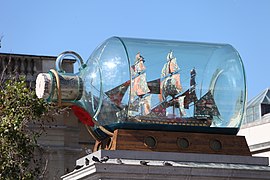
Cutty Sark is a British clipper ship. Built on the River Leven, Dumbarton, Scotland in 1869 for the Jock Willis Shipping Line, she was one of the last tea clippers to be built and one of the fastest, at the end of a long period of design development for this type of vessel, which ended as steamships took over their routes. She was named after the short shirt of the fictional witch in Robert Burns' poem Tam o' Shanter, first published in 1791.
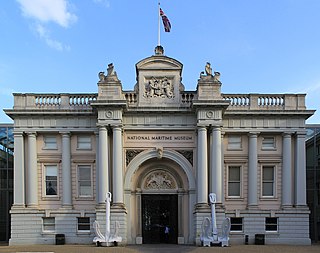
The National Maritime Museum (NMM) is a maritime museum in Greenwich, London. It is part of Royal Museums Greenwich, a network of museums in the Maritime Greenwich World Heritage Site. Like other publicly funded national museums in the United Kingdom, it has no general admission charge; there are admission charges for most side-gallery temporary exhibitions, usually supplemented by many loaned works from other museums.

The Summer Exhibition is an open art exhibition held annually by the Royal Academy in Burlington House, Piccadilly in central London, England, during the months of June, July, and August. The exhibition includes paintings, prints, drawings, sculpture, architectural designs and models, and is the largest and most popular open exhibition in the United Kingdom. It is also "the longest continuously staged exhibition of contemporary art in the world".
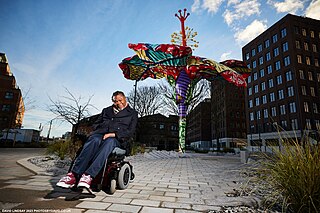
Yinka Shonibare, is a British artist living in the United Kingdom. His work explores cultural identity, colonialism and post-colonialism within the contemporary context of globalisation. A hallmark of his art is the brightly coloured Ankara fabric he uses. As Shonibare is paralysed on one side of his body, he uses assistants to make works under his direction.

Horatio Nelson, 1st Viscount Nelson (1758–1805) was a British flag officer in the Royal Navy famous for his participation in the Napoleonic Wars, most notably in the Battle of Trafalgar, during which he was killed. He was responsible for several famous victories that helped to secure British control of the seas, both securing Britain from French invasion and frustrating Napoleon's imperial ambitions. After his death during his defeat of the combined French and Spanish fleets at Trafalgar, there was a public outpouring of grief. Nelson was accorded a state funeral and was buried in St Paul's Cathedral.

The Swing, also known as The Happy Accidents of the Swing, is an 18th-century oil painting by Jean-Honoré Fragonard in the Wallace Collection in London. It is considered to be one of the masterpieces of the Rococo era, and is Fragonard's best-known work.
Sara Shamsavari is a British-Iranian interdisciplinary artist, photographer, designer and educator based in London.
Iniva is the Institute of International Visual Art, a visual arts organisation based in London that collaborates with contemporary artists, curators and writers. Iniva runs the Stuart Hall Library, and is based in Pimlico, on the campus of Chelsea College of Arts.

HMS Victory is a 104-gun first-rate ship of the line of the Royal Navy. She was ordered in 1758, laid down in 1759, and launched in 1765. With 246 years of service as of 2024, she is the world's oldest naval vessel still in commission.
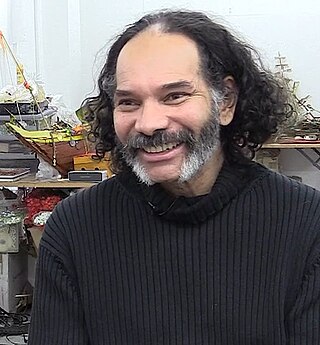
Hew Donald Joseph Locke is a British sculptor and contemporary visual artist based in Brixton, London. In 2000 he won a Paul Hamlyn Award and the EASTinternational Award. He grew up in Guyana, but lived most of his adult life in London.

The fourth plinth is the northwest plinth in Trafalgar Square in central London. It was originally intended to hold an equestrian statue of William IV, but remained empty due to lack of funds. For over 150 years, its use was debated; in 1998, the Royal Society for the encouragement of Arts, Manufactures and Commerce (RSA) commissioned three contemporary sculptures to be displayed temporarily on the plinth. Shortly afterwards, Chris Smith, Secretary of State for Culture, Media and Sport, commissioned Sir John Mortimer to seek opinions from public art commissioners, critics and members of the public as to its future. Mortimer's final report recommended that there continue to be a rolling programme of commissioned temporary artworks rather than settle permanently on one figure or idea.
Shape Arts or Shape is a British arts charity, working across the UK and internationally, funded by Arts Council England. It provides opportunities for disabled individuals wanting to work in the arts and cultural sector. It trains participants and runs arts and development programmes across all of the creative arts: visual arts, music, dance, writing and acting.

Hahn/Cock is a sculpture of a giant blue cockerel by the German artist Katharina Fritsch. It was unveiled in London's Trafalgar Square on 25 July 2013 and was displayed on the vacant fourth plinth. The fibreglass work stood 4.72 metres (15.5 ft) high and was the sixth work to be displayed on the plinth, on which it stayed until 17 February 2015. It was subsequently acquired by Glenstone, a private museum, and exhibited at the National Gallery of Art in Washington, DC, following its 2016 reopening. In March 2021, Glenstone permanently donated the piece to the National Gallery.
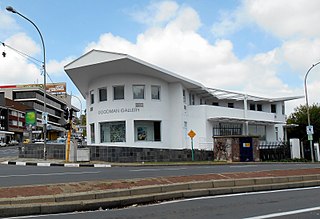
Goodman Gallery is an art gallery founded in Johannesburg, South Africa by Linda Givon in 1966. The gallery operates spaces in Johannesburg, Cape Town, and London. It represents both established and emerging artists who are regarded as having helped shape the landscape of contemporary art in Southern Africa.
African design encompasses many forms of expression and refers to the forms of design from the continent of Africa and the African diaspora including urban design, architectural design, interior design, product design, art, and fashion design. Africa's many diverse countries are sources of vibrant design with African design influences visible in historical and contemporary art and culture around the world. The study of African design is still limited, particularly from the viewpoint of Africans, and the opportunity to expand its current definition by exploring African visual representations and introducing contemporary design applications remains immense.

A bronze statue of British naval officer Horatio Nelson, 1st Viscount Nelson was installed at National Heroes Square in Bridgetown, Barbados from 1813 to 2020. It has since been relocated to the Barbados Museum.

The American Library is a 2018 contemporary art installation artwork piece by British-Nigerian artist Yinka Shonibare comprising 6,000 books of different sizes wrapped in Dutch wax printed cotton; 3,200 of the books carry names of immigrants, or the descendants of recent immigrants, to the United States who have had an impact on American culture. It was conceived as a reaction to Donald Trump's anti-immigration rhetoric.
The African Library is a piece of installation art created in 2018 by British-Nigerian artist Yinka Shonibare, based on his previous successful works The British Library and The American Library. It features books wrapped in Dutch wax printed cotton with named of prominent Africans on the spines. Shonibare intended the piece as commentary on the African struggle for liberation in European colonies, and the ability of Africans to be successful post-liberation.

Hibiscus Rising (2023) is an outdoor sculpture in Leeds, England, by artist Yinka Shonibare which was unveiled on 24 November 2023 as part of LEEDS 2023. It commemorates the life and death of David Oluwale, a British-Nigerian man whose death in 1969 involved two members of Leeds City Police. Commissioned by LEEDS 2023 and the David Oluwale Memorial Association (DOMA), in partnership with Leeds City Council, the sculpture is, according to academic Dr Emily Zobel Marshall the first public artwork in the city to reflect its cultural diversity.
